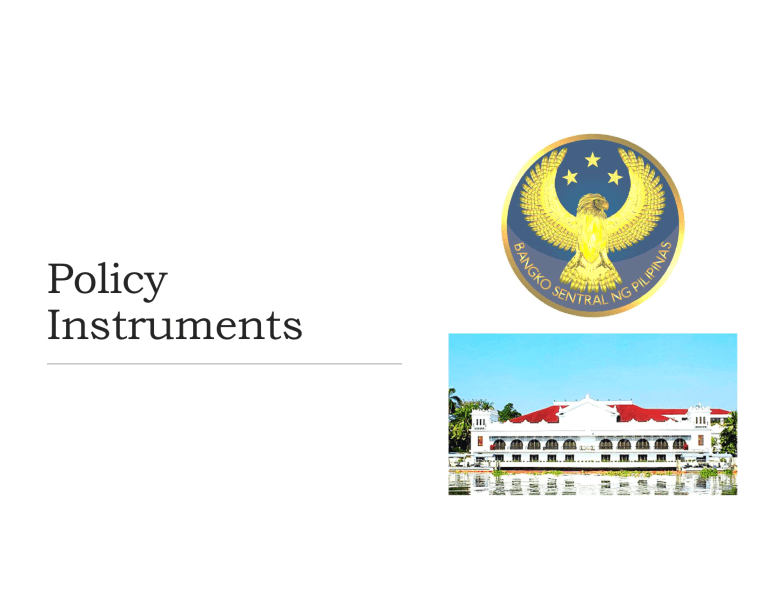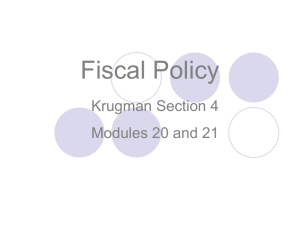
Policy Instruments Let’s Practice! The growth of BIR collections was dampened by the softening of economic growth and the passage of RA 9504 which raised personal exemptions for individual taxpayers effective July 2008. Tax collection of the BIR and BOC dropped due to lack of economic activities resulting from the pandemic and disasters, such as the Taal volcano eruption and ASF. Bangko Sentral ng Pilipinas decided to raise the interest rate on the overnight reverse repurchase facility by 50 basis points to 3.75 percent. BIR’s tax collection increased after a strong implementation of its Run After Tax Evaders (RATE) Program. • • What kind of policy is PBBM referring to in his tweet? Who takes charge of this type of policy? Definitions Fiscal Policy: the government’s use of taxes and spending to influence the level of economic activity (taken from slide 24 of Income and Spending PPT) ; economy stabilization by shifting the AD curve The government’s policy on the generation of its resources through taxation and/or borrowing, as well as the setting of the level and allocation of expenditures. Three components: revenue policy, expenditure policy, and debt management policy (Office of the Ombudsman) Revenue policy- to increase or raise revenue and for regulatory purposes; sources of revenue: tax and non-tax revenues Expenditure policy- disbursement of funds; government ensures that the level of expenditures is consistent with the approved surplus/deficit program for the year Debt management policy- policy to attain a manageable debt level Definitions Automatic stabilizers: government spending and taxation rules that cause fiscal policy to be automatically expansionary when the economy contracts and automatically contractionary when the economy expands Discretionary fiscal policy: result of deliberate actions by policy makers rather than rules Cyclically adjusted budget balance: estimate of what the budget balance would be if the economy were at potential output Debt-to-GDP ratio: government’s debt as a percentage of GDP Fiscal Policy Expansionary Fiscal Policy Contractionary Fiscal Policy ↑ 𝐺𝑜𝑣𝑒𝑟𝑛𝑚𝑒𝑛𝑡 𝑆𝑝𝑒𝑛𝑑𝑖𝑛𝑔, ↓ 𝑇𝑎𝑥𝑒𝑠 ↓ 𝐺𝑜𝑣𝑒𝑟𝑛𝑚𝑒𝑛𝑡 𝑆𝑝𝑒𝑛𝑑𝑖𝑛𝑔, ↑ 𝑇𝑎𝑥𝑒𝑠 Increases aggregate demand Decreases aggregate demand Can close recessionary gap Can close inflationary gap Higher budget deficits Reduces deficits Expansionary Fiscal Policy P LRAS SRAS0 P0 AD0 AD1 AD= C+I+G+NX Y1 Y* Y Contractionary Fiscal Policy P LRAS SRAS0 P0 AD1 Y* Y1 AD0 AD= C+I+G+NX Y Fiscal Policy Controversies Every dollar that the government spends is a dollar taken away from the private sector. So any rise in government spending must be offset by an equal fall in private spending.” False. Government spending crowds out private spending only when the economy is operating at full employment. Government borrowing always crowds out private investment spending False. Government borrowing crowds out private investment spending only when the economy is operating at full employment. Government budget deficits lead to reduced private spending Insufficient. Consumers will still spend at least a portion of their extra cash. Fiscal Policy Lags A government that tries too hard to stabilize the economy can end up making the economy less stable Time lags between when the policy is decided upon and when it is implemented Fiscal Policy and the Multiplier multiplier: ratio of change in real GDP caused by an autonomous change in aggregate spending to the size of that autonomous change how taxes affect the multiplier (reduce the size of the multiplier) Automatic stabilizers: government spending and taxation rules that cause fiscal policy to be automatically expansionary when the economy contracts and automatically contractionary when the economy expands Discretionary fiscal policy: fiscal policy that is a result of deliberate actions by policy makers rather than rules (legislation) Budget Balance Budget Balance: difference between the government’s revenue and its spending budget surplus- positive budget balance budget deficit- negative budget balance 𝑆 = 𝑇 − 𝐺 − 𝑇𝑅 expansionary fiscal policy- lower budget surplus or higher budget deficit contractionary fiscal- make budget surplus bigger or a smaller budget deficit Economists often use budget balance to assess whether current fiscal policy is expansionary or contractionary. Is this always correct? Budget Balance Using budget balance as a measure of fiscal policy can be misleading for the following reasons: Two different changes in fiscal policy that have equal-sized effects on the budget balance may have quite unequal effects on the economy. Changes in government purchases of goods and services have a larger effect on real GDP than equal-sized changes in taxes and government transfers (remember: Y=S-T+TR) Often, changes in the budget balance are themselves the result, not the cause, of fluctuations in the economy. Debt Debt-to-GDP ratio: government’s debt as a percentage of the GDP What does the debt-to-GDP ratio imply? Measures a country’s ability to pay Should a high debt-to-GDP ratio worry us? Philippines debt-to-GDP ratio Definitions Monetary Policy: policies conducted by the Bangko Sentral ng Pilipinas through decisions involving money supply and the cost of borrowing money to influence demand for goods and services Bangko Sentral ng Pilipinas Monetary Policy Monetary Policy Expansionary Monetary Policy Contractionary Monetary Policy ↓ 𝐾𝑒𝑦 𝑝𝑜𝑙𝑖𝑐𝑦 𝑟𝑎𝑡𝑒𝑠 ↑ 𝐾𝑒𝑦 𝑝𝑜𝑙𝑖𝑐𝑦 𝑟𝑎𝑡𝑒𝑠 Expands money supply Reduce money supply More lending/borrowing Less lending/borrowing Less savings More savings More spending Less spending Expansionary Monetary Policy P LRAS SRAS0 P0 AD0 AD1 AD= C+I+G+NX Y1 Y* Y Contractionary Monetary Policy P LRAS SRAS0 P0 AD1 Y* Y1 AD0 AD= C+I+G+NX Y • What kind of policy is PBBM referring to in his tweet? Monetary Policy • Who takes charge of this type of policy? BSP






